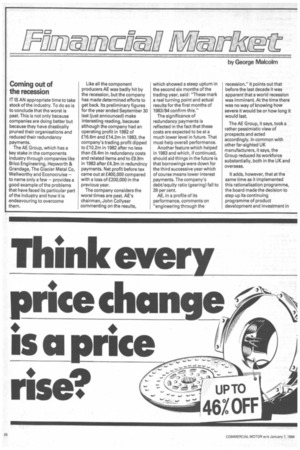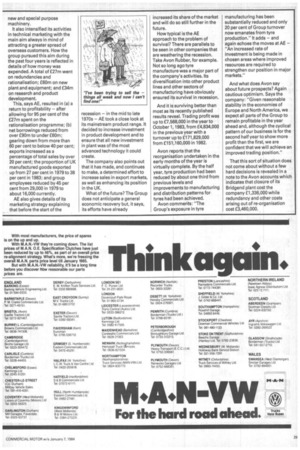EPJEmmmedm8 arra,E7023
Page 32

Page 33

If you've noticed an error in this article please click here to report it so we can fix it.
by George Malcolm
Coming out of the recession
IT IS AN appropriate time to take stock of the industry. To do so is to conclude that the worst is past. This is not only because companies are doing better but because they have drastically pruned their organisations and reduced their redundancy payments.
The AE Group, which has a key stake in the components industry through companies like Brico Engineering, Hepworth & Grandage, The Glacier Metal Co, Wellworthy and Econocruise — to name only a few — provides a good example of the problems that have faced its particular part of the industry and how it is endeavouring to overcome them. Like all the component producers AE was badly hit by the recession, but the company has made determined efforts to get back. Its preliminary figures for the year ended September 30 last (just announced) make interesting reading, because although the company had an operating profit in 1982 of £16.6m and £14.2m in 1983, the company's trading profit dipped to £10.2m in 1982 after no less than £6.4m in redundancy costs and related items and to £9.9m in 1983 after £4.3m in redundncy payments. Net profit before tax came out at £400,000 compared with a loss of £200,000 in the previous year.
The company considers the worst times are past. AE's chairman, John Collyear commenting on the results, which showed a steep upturn in the second six months of the trading year, said: "These mark a real turning point and actual results for the first months of 1983/84 confirm this."
The significance of redundancy payments is reflected in the fact that these costs are expected to be at a much lower level in future. That must help overall performance.
Another feature which helped in 1983 and which, if continued, should aid things in the future is that borrowings were down for the third successive year which of course means lower interest payments. The company's debt/equity ratio (gearing) fall to 39 per cent.
AE, in a profile of its performance, comments on "engineering through the recession." It points out that before the last decade it was apparent that a world recession was imminent. At the time there was no way of knowing how severe it would be or how long it would last.
The AE Group, it says, took a rather pessimistic view of prospects and acted accordingly. In common with other far-sighted UK manufacturers, it says, the Group reduced its workforce substantially, both in the UK and overseas.
It adds, however, that at the same time as it implemented this rationalisation programme, the board made the decision to step up its continuing programme of product development and investment in new and special purpose machinery.
It also intensified its activities in technical marketing with the main aim always in mind of attracting a greater spread of overseas customers. How the group pursued this aim during the past four years is reflected in details of how money was expended. A total of £27m went on redundancies and rationalisation; £60m on new plant and equipment; and £34m on research and product development, This, says AE, resulted in (a) a return to profitability — after allowing for 95 per cent of the £27m spent on the rationalisation programme; (bl net borrowings reduced from over £90m to under £60m; gearing down from more than 60 per cent to below 40 per cent; exports increased as a percentage of total sales by over 20 per cent; the proportion of UK manufactured goods exported up from 27 per cent in 1979 to 38 per cent in 1983; and group employees reduced by 45 per cent from 29,000 in 1979 to about 16,000 currently.
AE also gives details of its marketing strategy explaining that before the start of the recession — in the mid to late 1970s — AE took a close look at its mainstream product range. It decided to increase investment in product development and to ensure that all new investment in plant was of the most advanced technology it could create.
The company also points out that it has made, and continues to make, a determined effort to increase sales in export markets, as well as enhancing its position in the UK.
What of the future? The Group does not anticipate a general economic recovery but, it says, its efforts have already its share of the market and will do so still further in the tuture.
How typical is the AE approach to the problem of survival? There are parallels to be seen in other companies that are weathering the recession. Take Avon Rubber, for example. Not so long ago tyre manufacture was a major part of the company's activities. Its diversification into other product lines and other sectors of manufacturing have obviously ensured its survival in recession, And it is surviving better than most as its recently published results reveal. Trading profit was up to £7,568,000 in the year to October 1, 1983, from £4,834,000 in the previous year with a turnover up to £171,829,000 from £151,160,000 in 1982. remain profitable in the year Avon reports that the reorganisation undertaken in the early months of the year is virtually complete. By the half year, tyre production had been reduced by about one third from previous levels and improvements to manufacturing and distribution patterns for tyres had been achieved, Avon comments: "The Group's exposure in tyre manufacturing has been substantially reduced and only 20 per cent of Group turnover now emanates from tyre production." It adds — and again echoes the moves at AE — "An increased rate of investment is being made in chosen areas where improved resources are required to strengthen our position in major markets."
And what does Avon say about future prospects? Again cautious optimism. Says the company: "Given reasonable stability in the economies of Europe and North America, we expect all parts of the Group to ahead and, although the cyclical pattern of our business is for the second half year to show more profit than the first, we are confident that we will achieve an improved trading position."
That this sort of situation does not come about without a few hard decisions is revealed in a note to the Avon accounts which indicates that closure of its Bridgend plant cost the company £1,336,000 while redundancy and other costs arising out of re-organisation cost £3,460,000.










































































